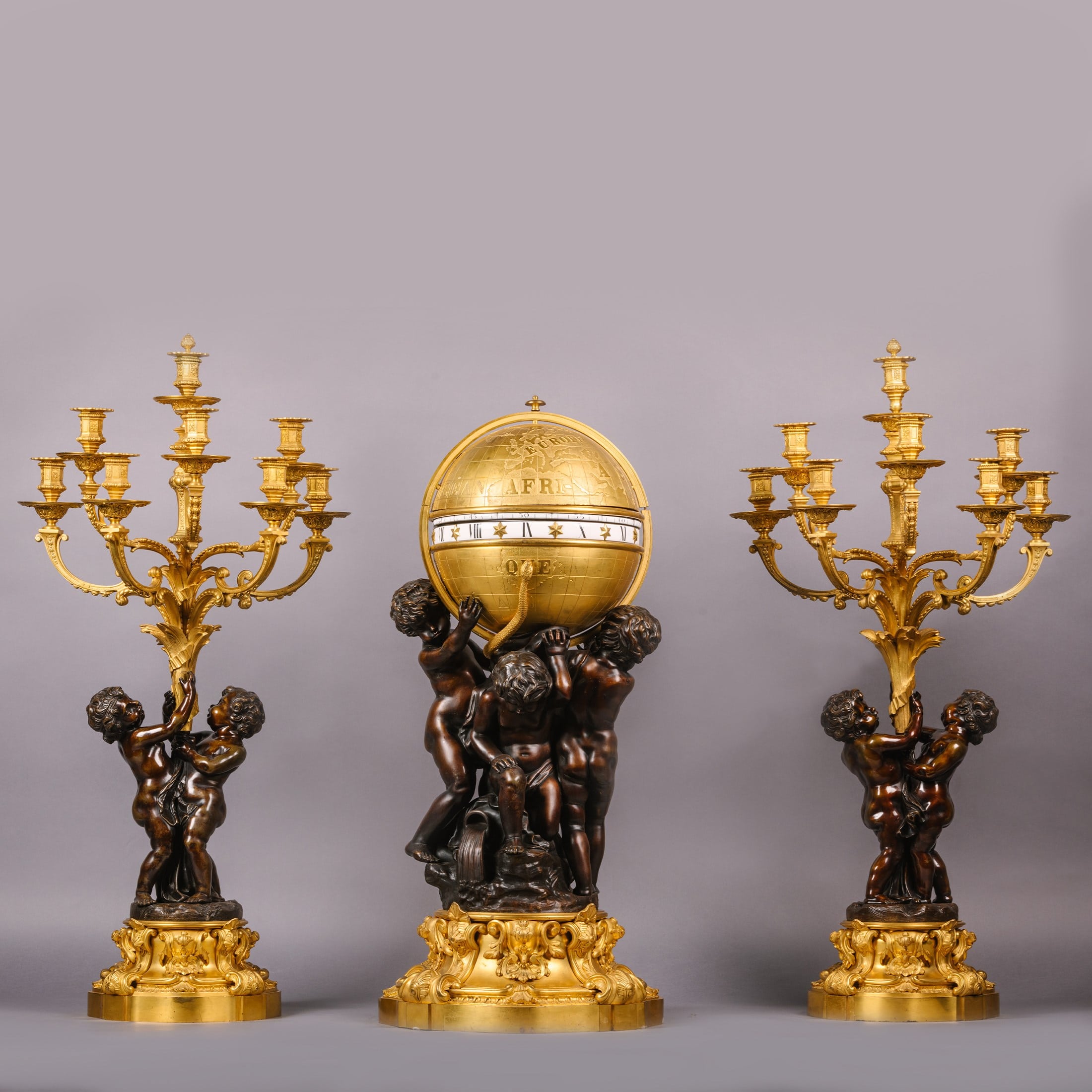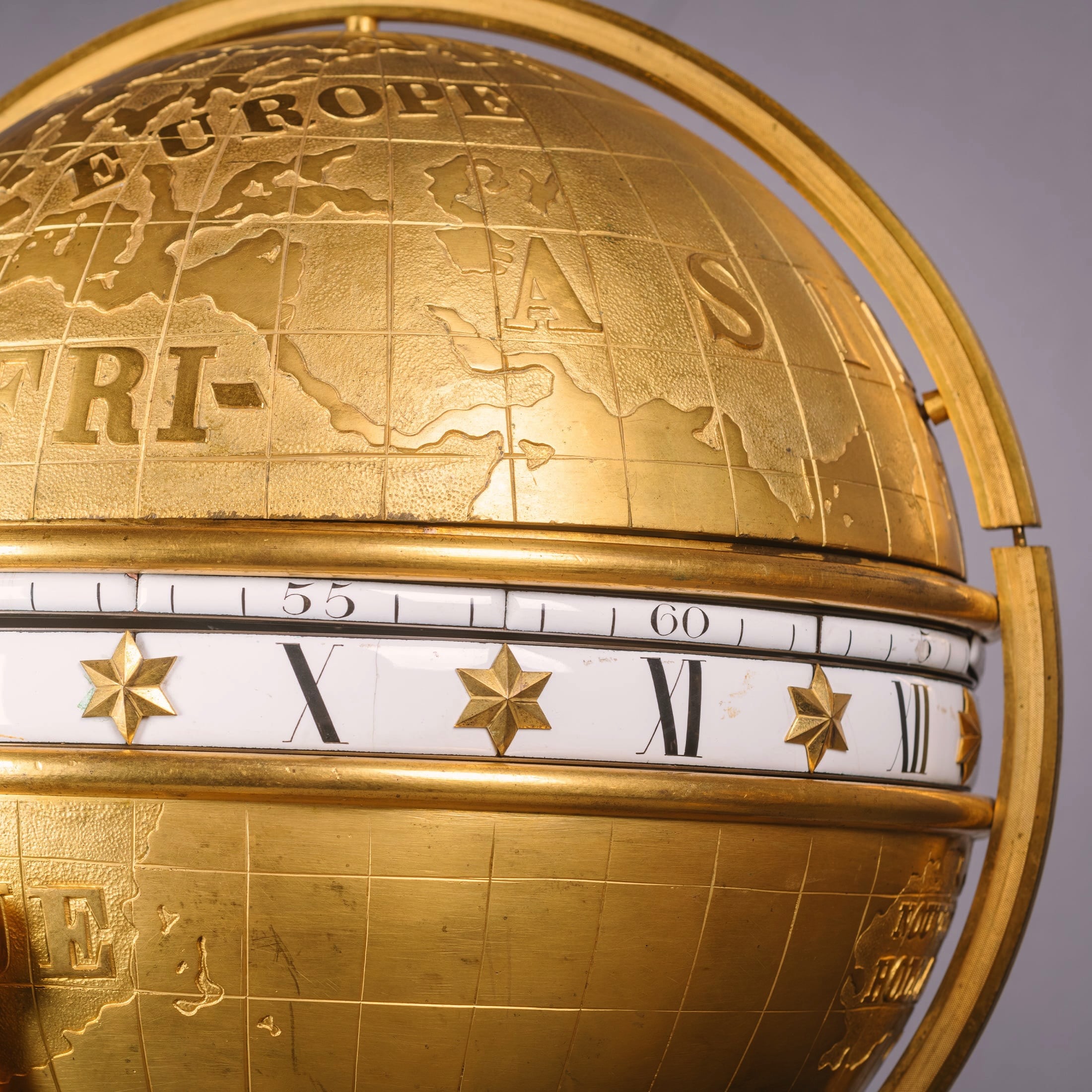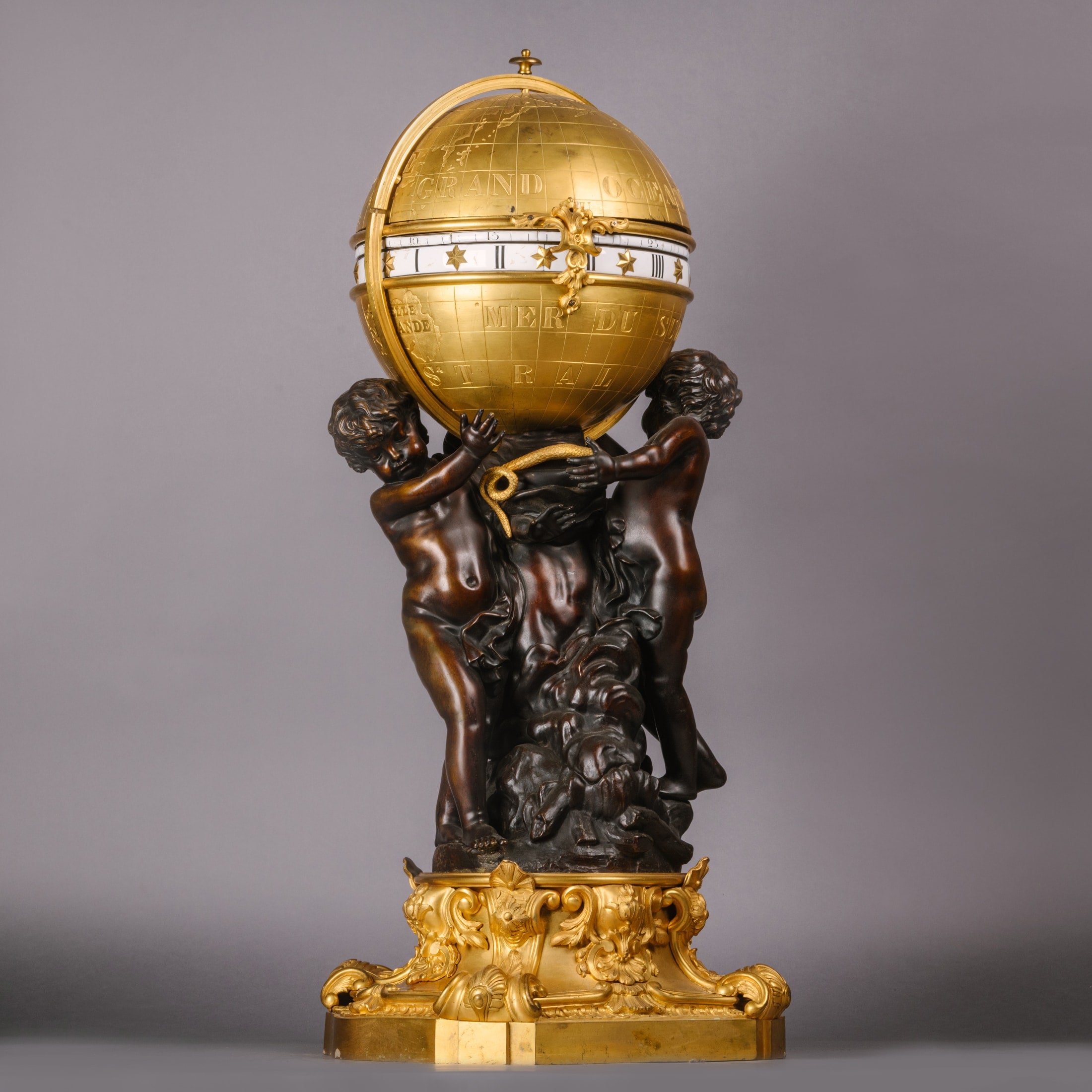Denière
A Rare Monumental Cercles Tournants Clock Garniture
£85,000
A Rare and Exceptional Gilt and Patinated Bronze Monumental Cercles Tournants Clock Garniture, by Deniere, Paris. The backplate signed 'DENIERE A PARIS...
Dimensions
Height: 88 cm (35 in)Description
A Rare and Exceptional Gilt and Patinated Bronze Monumental Cercles Tournants Clock Garniture, by Deniere, Paris.
The backplate signed ‘DENIERE A PARIS 3088’.
This large and imposing clock garniture comprises a finely chased cercles tournants clock in the form of a terrestrial globe supported by three paintated bronze putti, accompanied by a pair of eight-light candelabra en-suite, modelled after a design by Jean-Louis Prieur (1732-1795).
The eight-day twin-barrelled clock movement striking on a bell is contained within a terrestrial globe with two rotating enamelled dials with Roman numerals for the hours and Arabic numerals for the minutes, a gilt bronze snake wrapping around the base of the globe indicating the time. The globe is supported by three finely cast patinated bronze putti on a rockwork base with an overturned vase issuing water, emblematic of the Oceans and raised on a gilt-bronze acanthus cast re-entrant plinth base.
The candelabra en-suite are each modelled as a pair of patinated bronze putti on naturalistic bases with a conforming acanthus cast gilt-bronze plinth, holding aloft a foliate stem issuing eight candle arms terminating in circular drip-trays cast with ‘C’-scrolls, and octagonal candle nozzles cast with guilloche and shell decoration.
This exceptional clock is after an eighteenth century model, one example of which is in the collection of Victoria and Albert Museum, London. (Illustrated, Tardy, French Clocks the World Over, Paris, 1981, p. 101).
A further eighteenth century example, with a movement by Jean Romilly was owned by the celebrated collector, the 4th marquess of Hertford and kept at the château de Bagatelle, the former home of the Comte d’Artois. (Photographed in the salon at Bagatelle by Charles Marville, reproduced, B. Pons, French Period Rooms 1650-1800, Dijon, 1995, p. 60). Inherited by Sir Richard Wallace, and later Sir John Murray Scott, the clock was eventually sold by Christie’s, London, June 24-26, 1913, lot 258, for £241.10s to the dealer Wertheimer.
French, Circa 1860.
Dimensions
The clock
Height : 80 cm / 31 inches
Diameter : 35 cm / 14 inches
The candelabra
Height: 88 cm / 35 inches
Width: 42 cm / 17 inches
Depth: 30 cm / 12 inches
Date
Circa 1860
Origin
French
Medium
Gilt and Patinated Bronze
Signature
The backplate signed 'DENIERE A PARIS 3088'
Jean-François Denière (1774-1866)
At the end of the 18th century, Jean-François Denière (1774 – 1866) founded a workshop in Paris with François Matelin, at n¬∞15, rue Vivienne in Paris. The company prospered significantly under the Empire and the reign of Louis Philippe, employing nearly two hundred artisans. His association with Matelin ended in 1820.
Along with Pierre-Philippe Thomire, Jean- François Denière was one of the main proponents of Egyptian taste in the decorative arts, influenced in part by Baron Vivan-Denon. In 1822, he received the title of Supplier to the King and counted amongst other clients the Duchess of Berry and the King of Spain.
He was joined in the business by his son Guillaume Denière (1815-1903) from 1844, the company being renamed ‚‘Denière et fils‚’. Guillaume studied art under the direction of the renowned French ornamentalist Aimé Chenavard (1798-1838) and the architect Henri Labrouste (1801-1875).
Guillaume produced bronzes for furniture, candelabras, clocks, and table centrepieces, expanding the business to employ over 400 workers. He collaborated with numerous artists of the day including Carrier-Belleuse (1848-1913) and Constant Sévin (1821-1888).
He delivered several clocks (Genius of the Arts, Woman reading with a dog) for the Tuileries Palace in 1852 and in 1854 delivered a spectacular bronze centrepiece to the Russian Ambassador Kisselef, as well as decorative bronzes for the viceroy of Egypt, Saïd Pacha, in 1862.
Renowned for the quality of its production, Denière et fils exhibited at many of the great exhibitions of the period, including the London International Exhibition of 1862 where they exhibited a flower stand of grand proportions, illustrated in J. B Waring, Masterpieces of Industrial Art & Sculpture, 1863, and a mantel garniture at the 1867 Paris Exhibition Universelle, purchased by Napoleon III.
Two mid-19th century clocks by Denière are in the Royal Collection Trust.
Tardy cites the firm as being active until 1890.
Literature:
Tardy, ‘Dictionnaire des Horologers Francais’, Paris 1972.















 Print
Print


